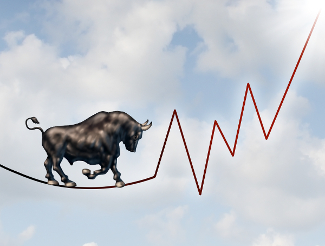Stock market bulls in the financial media love to tout high stock prices as proof that the economy is doing well and that good times will continue indefinitely. But while high stock prices (and the amazing volatility of the past year) have benefited many traders on Wall Street, they haven’t benefited investors and retirees.
After stocks reached all-time highs last year they began to plummet, before reaching highs again late in the year. That was followed by one of the worst fourth quarters in history, then one of the best first quarters in history as stock markets once again move towards all-time highs. But while the multi-thousand-point price swings have benefited those who have been able to time the market correctly, they haven’t benefited most investors.
Timing Markets Is Risky
One of the key mantras repeated by most financial advisers is not to try to time markets. Buy and hold is the reigning strategy, and for good reason. Most people, even professional traders, are just not good enough to be able to predict market movements with any accuracy. After all, after last year’s double top who would have predicted that markets would be pushing towards a potential triple top? Who would have predicted that after a drop below 22,000 the Dow would once again move above 26,000?
With most investors engaged in buy and hold investing, they’re looking to hold assets for the long term. Their ability to use their assets to fund their retirements is based on annual growth. And the annual growth of stock markets over the past year is just about zero.
Traders who bought into the Dow Jones a year ago and sold at the top in October, bought back in at the low in December and sold out again today could have made gains of 34%. That’s a pretty phenomenal return for a single year. But it requires such luck that no one is really capable of seeing returns like that.
The average investor is looking to make gains of at least 6-8% per year before retirement and at least 4% per year in retirement. For those who are already drawing on their 401(k) and IRA retirement accounts, the stock market movements of the past year have meant that they are drawing down principal when they would rather be living off gains. And with every indication being that the Dow Jones won’t break the 27,000-point level, stocks are more likely to stumble and fall than they are to continue making new gains.
Maintaining Wealth Is the Name of the Game
At this point most investors need to start thinking about maintaining their current assets if they haven’t already. Those most heavily invested in stocks are most at risk in the event of a financial market meltdown. But even those who think that they’re safe by investing in bonds are at risk too. Bonds have been in a multi-decade bull market. But with interest rates set to rise, bond prices will sink, further eroding many Americans’ retirement savings.
The American economy is in the middle of a huge and dangerous bubble right now, and when that bubble bursts the prices of many assets will come tumbling down. Investors who haven’t prepared for that will learn very quickly that the wealth they thought they had was ephemeral. An investment strategy that relies on or hopes for the continuation of an asset bubble to support future price growth is a strategy that will get rocked when that asset bubble collapses.
That’s why many investors look to hedge their portfolios with precious metals such as gold. Not only is gold a tangible asset, but it’s also an asset that has been highly desired by investors for centuries. Gold maintains its price in the face of economic crisis and financial turmoil, and it’s that stability that continues to make it a popular investment.
Gold’s slow and steady price growth continues even during the worst of a financial crisis, which many fortunate gold investors found out in 2008. While stocks lost over 50% of their value from their peak in late 2007, gold gained 25%, and then continued to gain in value as the economy sputtered over the next few years. Even central banks learned the lesson of 2008, which is why central bank gold buying reached near-record levels in 2018. No one is immune from the effects of a financial crisis, which is why central banks want to secure their balance sheets with the stability of gold.
Stocks may be great for building wealth during boom times, but when the bust comes investors quickly find out that all their wealth was built on sand. Only gold has the stability and solidity to secure investors’ wealth and ensure their ability to maintain their well-being into retirement.
This article was originally posted on Goldco.




